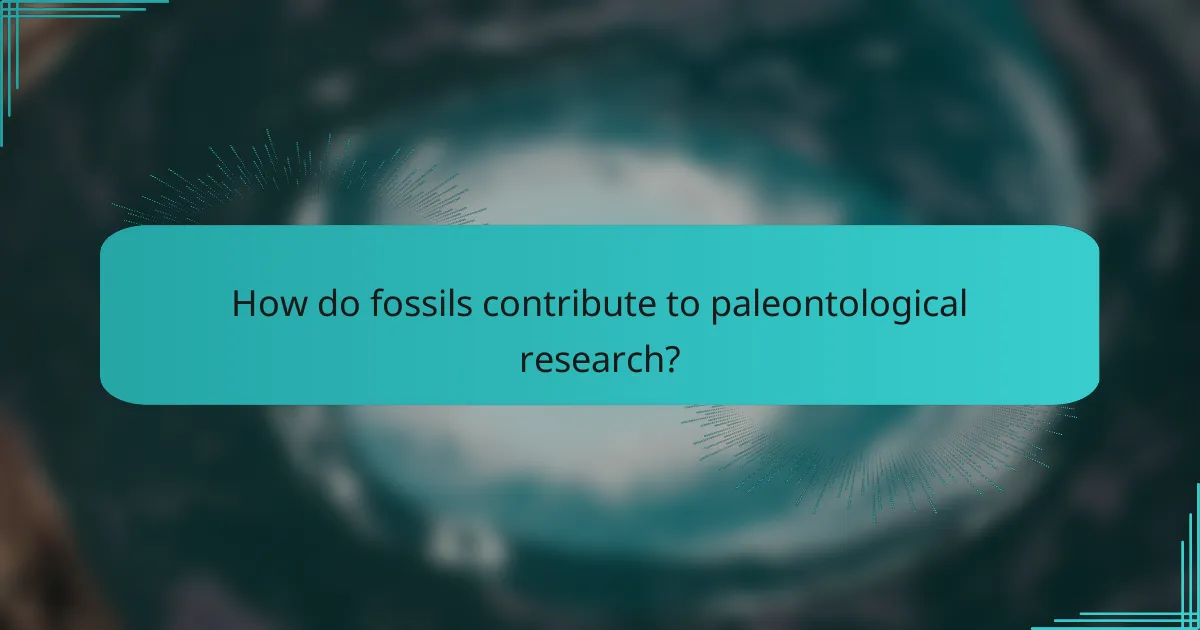Fossils serve as vital records of biological history, revealing the diversity of life and environmental conditions that existed millions of years ago. Through the study of fossils, scientists can trace evolutionary changes and assess how organisms have adapted to shifting climates. Additionally, various preservation methods, such as mineralization and encapsulation, are essential for maintaining the integrity of these invaluable specimens, ensuring that they continue to inform our understanding of past ecosystems and their transformations.

How do fossils provide insights into biological history?
Fossils are crucial for understanding biological history as they offer tangible evidence of past life forms and their environments. By studying fossils, scientists can reconstruct the evolutionary timeline and gain insights into how organisms adapted to changing conditions over millions of years.
Fossil records document evolutionary changes
Fossil records serve as a timeline for evolutionary changes, showcasing how species have evolved over time. By examining the physical characteristics of fossils, researchers can identify transitional forms that illustrate the gradual changes between species. For example, the fossilized remains of early mammals provide evidence of their evolution from reptilian ancestors.
These records also highlight patterns of diversification and extinction, allowing scientists to understand the dynamics of life on Earth. The appearance and disappearance of certain species in the fossil record can indicate significant evolutionary events, such as mass extinctions or adaptive radiations.
Fossils reveal ancient ecosystems
Fossils provide a window into ancient ecosystems, revealing the types of organisms that coexisted and their interactions. By analyzing fossilized plants and animals, researchers can reconstruct habitats and understand the ecological relationships that existed millions of years ago. For instance, the presence of certain plant fossils can indicate the climate and environment of a region at that time.
Additionally, studying fossilized remains of organisms, such as pollen or shells, helps scientists infer the biodiversity and ecological dynamics of past environments. This information is vital for understanding how ecosystems respond to environmental changes over time.
Fossils indicate climate changes over time
Fossils are key indicators of climate changes throughout Earth’s history. By examining the types of organisms that thrived in different geological periods, scientists can infer past climate conditions. For example, the presence of tropical plant fossils in currently temperate regions suggests that those areas experienced warmer climates in the past.
Moreover, isotopic analysis of fossilized materials can provide quantitative data on historical temperature fluctuations and atmospheric composition. This information is essential for understanding the natural climate cycles and the impact of current climate change on biodiversity.

What are effective fossil preservation methods?
Effective fossil preservation methods include mineralization techniques, freezing and refrigeration, and encapsulation in resin. Each method has unique processes and considerations that can significantly impact the quality and longevity of the fossil record.
Mineralization techniques
Mineralization involves the gradual replacement of organic material with minerals, typically occurring over thousands to millions of years. This process can preserve fine details of the organism, making it a favored method for fossilization in sedimentary environments.
Common minerals involved in this process include silica, calcite, and pyrite. The surrounding conditions, such as temperature, pressure, and the presence of mineral-rich water, play a crucial role in the effectiveness of mineralization.
Freezing and refrigeration
Freezing and refrigeration are effective methods for preserving fossils, particularly in cases where immediate fossilization is not possible. These techniques slow down decay processes and prevent the degradation of organic material.
For instance, fossils can be stored in temperatures below -18°C (0°F) to maintain their integrity. This method is particularly useful for delicate specimens that may be damaged by traditional fossilization processes.
Encapsulation in resin
Encapsulation in resin is a method where fossils are preserved by encasing them in a clear synthetic or natural resin. This technique protects the fossil from environmental factors and physical damage, while also allowing for visibility and study.
When using resin, it’s essential to choose a type that is stable and non-reactive. Epoxy resins are commonly used due to their durability and clarity. However, care must be taken to avoid trapping moisture, which can lead to deterioration over time.

How are fossils used in environmental studies in Canada?
Fossils play a crucial role in environmental studies in Canada by providing insights into historical climate conditions and biodiversity. Researchers analyze fossil records to understand how ecosystems have changed over time, which aids in predicting future environmental shifts.
Fossils help assess past climate conditions
Fossils serve as valuable indicators of past climate conditions by revealing the types of organisms that thrived in different environments. For instance, the presence of certain plant fossils can suggest a warmer or cooler climate, while marine fossils indicate historical sea levels.
In Canada, paleoclimatologists often study sediment cores containing fossils from lakes and oceans to reconstruct climate patterns over thousands to millions of years. This data helps in understanding how current climate change may affect ecosystems.
Fossils inform biodiversity conservation efforts
Fossils provide essential information for biodiversity conservation by illustrating historical species distributions and ecosystem dynamics. By examining fossil records, scientists can identify species that have adapted or gone extinct due to past environmental changes, guiding current conservation strategies.
In Canada, this knowledge is crucial for protecting endangered species and habitats. For example, understanding the historical range of a species can help in creating effective management plans to ensure their survival amidst ongoing habitat loss and climate change.

What are the challenges in fossil preservation?
Fossil preservation faces numerous challenges, primarily due to environmental factors and natural events that can disrupt or destroy fossil sites. Understanding these challenges is crucial for effective conservation and study of fossil records.
Environmental degradation impacts fossil sites
Environmental degradation, such as pollution, climate change, and habitat destruction, poses significant threats to fossil sites. These factors can lead to erosion, sediment displacement, and loss of geological context, making it difficult to locate and study fossils.
For example, increased rainfall and flooding can wash away sediment layers that contain fossils, while urban development can obliterate entire fossil-rich areas. Protecting these sites requires awareness and proactive measures to mitigate human impact.
Natural disasters can destroy fossil records
Natural disasters, including earthquakes, volcanic eruptions, and landslides, can severely damage or completely obliterate fossil records. Such events can alter landscapes and bury or expose fossils in ways that complicate their recovery.
For instance, a volcanic eruption may encase fossils in ash, preserving them temporarily but making them difficult to excavate later. Understanding the geological stability of fossil sites can help in planning excavation efforts and minimizing loss during such events.

What are the key fossil types found in Canada?
Canada is home to a diverse range of fossil types, primarily including marine fossils and plant fossils. These fossils provide crucial insights into the biological history and environmental conditions of ancient ecosystems across the country.
Marine fossils from the Burgess Shale
The Burgess Shale, located in British Columbia, is renowned for its exceptional preservation of marine fossils from the Cambrian period. This site contains a variety of soft-bodied organisms, including early arthropods and other invertebrates, which offer a glimpse into the complexity of ancient marine life.
Fossils from the Burgess Shale are significant for understanding evolutionary biology, as they showcase the rapid diversification of life forms during the Cambrian explosion. Researchers often study these fossils to gain insights into early ecological interactions and the development of complex ecosystems.
Plant fossils from the Coal Age
During the Coal Age, which spanned from the late Carboniferous to the early Permian periods, Canada was covered by lush forests that contributed to extensive coal deposits. Plant fossils from this era, including ferns, cycads, and early gymnosperms, provide valuable information about prehistoric climates and vegetation.
These plant fossils are often found in sedimentary rock formations and can help reconstruct ancient environments. Understanding the distribution and types of these fossils allows scientists to infer past climate conditions and the evolution of plant life over millions of years.

How do fossils contribute to paleontological research?
Fossils are essential to paleontological research as they provide direct evidence of past life forms and their environments. By studying fossils, scientists can gain insights into biological evolution, climate changes, and the ecological dynamics of ancient ecosystems.
Fossils aid in reconstructing ancient life forms
Fossils serve as crucial records of ancient organisms, allowing researchers to piece together the morphology and behavior of species that existed millions of years ago. For example, well-preserved dinosaur bones can reveal information about their size, structure, and even potential movement patterns.
Additionally, trace fossils, such as footprints or burrows, offer insights into the behavior and interactions of ancient species. These findings help scientists understand evolutionary trends and the adaptations that allowed certain species to thrive in their environments.
Fossils support geological dating techniques
Fossils play a vital role in geological dating, particularly through biostratigraphy, which uses the distribution of fossils to date rock layers. By identifying specific fossil species within a layer, geologists can establish a relative age for that layer, aiding in the understanding of Earth’s history.
Moreover, certain fossils, known as index fossils, are particularly useful for dating because they were widespread but existed for a relatively short geological period. This makes them excellent markers for correlating the ages of rock formations across different regions.

What future trends are emerging in fossil research?
Future trends in fossil research are increasingly focused on advanced technologies and interdisciplinary approaches. These developments aim to enhance our understanding of biological history and environmental changes through more precise analysis and preservation methods.
Advancements in imaging technology
Imaging technology is revolutionizing fossil research by allowing scientists to visualize internal structures without damaging specimens. Techniques such as micro-CT scanning and 3D imaging provide detailed insights into fossil morphology and composition.
These advancements enable researchers to analyze fossils in unprecedented detail, revealing features that were previously hidden. For example, micro-CT can uncover soft tissue remnants and cellular structures, offering clues about ancient life forms and their environments.
To effectively utilize these imaging technologies, researchers should consider the resolution and scale of the images required for their specific studies. Balancing the cost of high-resolution imaging with the potential insights gained is crucial for efficient research planning.


